

The term ‘barbarous coinage’ refers to
imitative coins which are often crude in style. There are
several theories about the origins of these coins but the
easiest and possibly best explanation is that they were minted
because of a shortage of official coinage. This easy
explanation surely does not answer every question though, like
why fourth century imitations do not turn up as often (in
comparison to rest of the Empire) in what is now Spain, even
though the diocese
of Hispaniae did not have a mint. So there are no easy answers
or maybe there are some aspects of this that historians are
missing. Firmicus Maternus, who lived in the fourth century,
even said that an alignment of the stars and planets influenced
forgery. Maternus was probably wrong, though!
Mars allots 20 months to Mercury. When Mercury accepts these months he rouses certain dangers from things written, or he inflicts loss from forgeries. But often he will have enemies destroyed in various ways. If Mercury and Venus are in conjunction, in square aspect, or in opposition, they indicate the crimes of forgery and counterfeiting, especially if Mercury is found in the house or terms of Saturn. Ancient Astrology: Theory and Practice 35:6.This page is about unofficial coinage in the fourth century, specifically the time between A.D. 318- 363. The production of these coins during this period occurred mainly in the outskirts of the Empire-- Britain, Gaul and the Danube, and this page will later look at the Danube region, specifically the Middle Danube. This page will also focus on struck coins versus cast copies-- even though some coins of this type were cast. Coins have been copied practically since the first one was minted. There are two terms in use to describe how widespread counterfeiting was-- endemic and epidemic.1 Endemic is typified by smaller outbreaks and although somewhat sporadic, was almost always present to some extent. Epidemic counterfeiting was on a large scale and generally over a large area. The time period 318- 363 had five periods of epidemic counterfeiting.2 The first was after the monetary reform of Constantine in 318 and lasted until 330. This reform included adding more silver to the VLPP coinage (the imitative/counterfeit VLPP's are the real focus of this page). Other coins that were commonly copied during this first period were VIRTVS EXERCIT, BEATA TRANQVILLITAS, VOTA, SARMATIA and PROVIDENTIAE coins. The second period started during the last years of Constantine's reign and ended between 342 and 348. Some common counterfeits were GLORIA EXERCITVS, VRBS ROMA and CONSTANTINOPOLIS types. The third period came after the reform of 348 which introduced the maiorina and the commonly copied coins were the various FEL TEMP REPARATIO types. The fourth period followed the usurpation of Magnentius in A.D. 350, GLORIA ROMANORVM and VICTORIAE coins were some of the common types counterfeited. The last period of epidemic counterfeiting occurred after the fall of Magnentius. The maiorinae was replaced by the half maiorinae and the FEL TEMP fallen horseman types were the most common type counterfeited. Counterfeiting of bronze coins still happened after this time but declined greatly due to the introduction of the siliqua.
Epidemic outbreaks of counterfeiting A.D. 318- 363
|
|
|
|
|
|
|
|
|
|
|
|
|
|
|
|
|
|
Counterfeits
I have used various terms to describe these coins, but I believe that there are distinctions. "Unofficial" is a good blanket term for any coin that was not struck officially-- then there are counterfeits and imitations. Counterfeits were made to fool people and circulate as official coinage. Some of these coins do indeed look official and would pass casual inspection. In fact, it seems most likely that some of these counterfeiters worked in the mint, as evidenced by this announcement from Constantine in A.D. 321--
"Since some imperial minters are secretly and criminally engaged in the coinage of counterfeit (adulterinus) money, all shall know that the necessity is incumbent on them of seeking out such men, that they be tracked down and delivered to the courts, so that they may forwith betray the accomplices of their deeds through torture and thereupon be sentenced to suitable punishments." Theodosian Code 21:2So some of these coins were minted in an attempt to deceive. The large amount of these copies is “indicative of the heavy overtariffing of the official coinage.”3 This meant that people could make copies of the official coinage for less than the official money was worth. The official VLPP had as much as 3-5% silver, while the previous coinage that was de-monetized had around 1-3% silver. If someone made imitations by melting down the old coins, a nice profit could be made.4 You could actually make money hand over fist!5 People at the time were very aware that bronze coins had silver in them. There is even a law from A.D. 349 aimed at mint employees removing silver from bronze coins.
We have learnt that many metalworkers (flaturarii) are purging the maiorina coin (maiorina pecunia) no less criminally than frequently by separating off the silver the bronze. Therefore, if anyone is caught in this operation from now on let him know that he is to suffer capital punishment, and indeed those who own the house or land that they are to be punished by the confiscation of property to the largitiones: Our Clemency is naturally to be informed of the names. Theodosian Code 21:6
Some of these coins probably came from
“well organized work-shops.”6
It appears that mint workers may have been able to "borrow"
official reverse dies and use them in their workshops. The
obverse dies( with the imperial portrait) were kept locked up
when not in use. 7So some
of these coins look very good in style and that is why I would
call them counterfeits versus imitations-- as there seems to be
intent to deceive. On the other hand, imitations would not have
really fooled anyone because the style was often crude.These
crude imitations would not have had to come from well-organized
workshops, but could have been minted nearly
anywhere...including a farm-- "if money should be secretly
stamped and coined on a farm or at a house..." (Theodosian Code
21:4) Generally, imitations of coins from the first period, like
the VLPP, were very close in size and usually about 4/5 of the
weight. Sometimes these imitations were even silvered, just like the official
issues. As time went on, the imitations became reduced in size
and become very small. These small imitations are called
minimissimi. It is not known for sure what any of these
imitations(normal or reduced size) traded for, but a few hoards
comprised of almost all imitations suggest that these coins were
not worth as much as official coinage. 8
Imitations
The fourth century was a time of great change in the Roman Empire. Many Germanic people were living in Roman territory. The Roman Empire needed the influx of people for labor, to farm the land and protect the borders from other Germanic people. During the reign of Constantius I, “the whole nation of the Carpi was transferred”(Aurelius Victor, De Caesaribus 39: 28) to Roman land. So some of these barbarous tribes actually lived in the Roman Empire, with many more near the borders or limes. The Romans called them foederati. The foederati were allies of Rome, but not citizens. Circa 332, Constantine was victorious over the Goths and he converted them “from a lawless animal existence to one of reason and law. In this way the Goths learnt at last to serve Rome.”(Eusebius, Life of Constantine book IV, 5) so along the borders, the population was probably actually more ‘barbarian’ than Roman. These Roman borders were very porous, and there was a lot of movement back and forth, especially in the Middle Danube.
Could Germans (living in Roman territory or near the limes) have minted some of these coins? Could these coins have been a form of notgeld (emergency coinage) or monnaie de nécessiteé? The area of the near the limes most likely to have seen these coins used would have been the Middle Danube ( now modern day SW Slovakia, S Moravia and lower Austria north of the Danube). This area was under "strong Roman influence as a result of its proximity to the Roman Empire."9 So, yes...of course they could have minted these imitatives,since they were more than capable and had for many years been using Roman money. Tacitus (who wrote Germania in the first century A.D.) said that the Germanic tribes, “value gold and silver for their use in commerce, and are wont to distinguish and prefer certain of our coins. They like old-fashioned coins because they have been long familiar with them-- especially those which have notched edges and are stamped with representations of two-horse chariots.” (Tacitus Germania Book 5) Tacitus also said that Germans only used coins as currency on the frontiers, while in the interior coins were treated as bullion. (Tacitus Annals 12:30) The Germans are known to have made copies of denarii, aurei, siliquae and solidi, so it seems quite likely that they would have also minted imitations in bronze . 10There is also a clear picture of Germans using Roman products in the Middle Danube region. There are Roman imports of all kinds and not just luxury items (see fig. 1 below)-- in other areas of Barbaricum luxury goods usually only turn up in graves. Roman tableware is found and there is a widespread distribution of Roman pottery (some of which may have been only for export to the Germans, as it does not appear inside Roman territory) which demonstrates that Roman influence extended to all levels of Germanic society in the Middle Danube area (see fig. 2 below). There have even been buildings excavated that were built in the Roman style (hypocaust heating and one with a bath house) but apparently used by Germans. In the fourth century, Roman traders would have re-introduced coinage into this area. "Roman coins were not confined to transactions with Romans, but were used in exchanges between Germans as well, whereas in regions more distant from the frontier Roman coins were regarded as bullion rather than currency."11 There is also a high proportion of bronze to gold and silver (just like in Pannonia) which suggests everyday usage and the large number of coins that are found represents casual loss versus intentional hoarding.12
Many of these imitations are found along the limes, especially in the Danube and Balkans regions and it is reasonable to assume that wherever large amounts of imitations turn up, it is probably the vicinity that they were also minted.
Many of these VLPP imitations (especially the Siscian ones) have crude legends. These imitative coins almost never got the Latin legends correct. This is no surprise ( if these coins were minted by Germans or for use by them), since most of the barbarians could not read or write Latin--they did not even have their own written language. Of course, it would have been easier for anyone making imitative coins to engrave only lines rather than actual letters. You also have to wonder what Germanic people, who did not read or write (and may not have even understood the concept), saw when they looked at the legends on a Roman coin. These people probably saw nothing more than curious designs or decorations. As a result, the engraver could use nonsensical symbols instead of Latin and no one cared. Remember also that by the Roman definition that is why they were barbarians. Barbarians were any people that did not read or write Latin (and especially those that wore pants!).13 The Romans used the term barbarian in a negative sense, though. It would probably be better to refer to this type of coinage as imitative rather than the term "barb". The people that produced these coins were not actually barbarians and really only wanted a better life for themselves and their family...and they saw opportunity in Rome.

both of the above figures are from Pitts, Lynn F. “Relations Between Rome and the German ‘Kings’ on the Middle Danube in the First to Fourth Centuries A.D.” JRS 79 (1989) : 45- 58.
The stylistic differences on these coins
makes more sense in the terms of a different culture. Some of
the VLPP’s for example, bear little resemblance to the familiar
figure of two victories holding a shield over an altar. To a
Germanic engraver, this imagery would not have been quite so
familiar, and so it became so highly abstract that one may have
difficulty recognizing the original model. Maybe the engraver
knew that the people that would use these coins would not know
better or even care. Some examples seems to show that the
engravers were copying previous barbarous issues instead of
official versions of the VLPP-- as if they did not care
what the official coinage looked like. Sometimes the style is
very good on these coins, but other times the style is so
abstract that it is hard to tell what the engraver wanted to
depict. So even if these coins were not minted by
‘barbarians’, it seems plausible that the coins were meant to be
used by the Germanic people and others.
Why was the Siscian VLPP so widely
copied? Constantine defeated Licinius in the 1st civil war in
A.D. 317 and took over the territory of Siscia. He soon began
striking the VLPP
coinage; which was a reintroduction of a type Constantine
struck after the defeat of Maxentius, though the earlier type
was in billon. This new VLPP did have about 4% silver, versus
the old IOVI coinage of about 2%; which Licinius continued to
strike in his territory. So, almost overnight, people wanted
Constantine's new and improved coinage. The mint of Siscia could
not have struck coins fast enough. Sometimes you can even find
IOVI coins overstruck with unofficial VLPP's, showing the
immediate need for "good" coinage. It seems that Constantine's
reuse of the "Eternal Prince" reverse was a shot at Licinius and
his re-tarrifing was a further line in the sand. Constantine was
basically saying that not only was Licinius a lesser Emperor,
but his coinage was worthless. As widespread as unofficial
VLPP's became, it seems that much of the Empire and surrounding
areas agreed. Licinius eventually began striking his coinage at
an even further reduced value (the reverse even said they were
worth 12.5-- half of the regular nummus) and continued to lose
support and his currency became almost worthless.
There were multiple laws passed
condemning counterfeiting. The fact that so many laws were
passed possibly tells a lot about what was going on. One law
would indicate a problem...multiple laws meant that there was a
much bigger problem. Part of the problem was the inability of
the Imperial government to stop counterfeiting and this stemmed
from the fact that on a local level, little or nothing was or
could be done to stop the problem. For instance, in a province,
the local authority might not care at all if the people minted
stop-gap currency to alleviate a shortage of official coinage.,
after all what kept the people happy made for a peaceful
province. Even if the local official wanted to stop illegal
minting, he may not have had the manpower and/or
resources to stop it. The further away from the Emperor, and the
reach of the Emperor, the less of a problem counterfeiting
imitatives probably seemed to people. It seems likely, that for
the most part, imitatives were tolerated.
Theodosian Code 9:21:2
Since some imperial minters are secretly and criminally
engaged in the coinage of counterfeit money, all shall know
that the necessity is incumbent on them of seeking out such
men, that they may be tracked down and delivered to the
courts, so that they may forthwith betray the accomplices of
their deeds through torture and thereupon be sentenced to
suitable punishments. (20 November 321)
9:21:3
If any person should mold a coin by false casting, We command
that all his property shall be confiscated to the fisc and
that he shall be punished with statutory severity, in order
that such zeal for coining money may prevail only in Our
mints. (6 July 326)
9:21:4
It was formerly established as law that, if money should be
secretly stamped and coined on a farm or at a house without
the knowledge of the owner, the fisc should vindicate to its
own ownership the seat of the crime. Now it is our pleasure
that a distinction shall be made, namely that if the owner
dwells…at a very long distance from the said house or
landholding, he shall sustain no loss. (4 May 326)
9:21:5
A reward is offered to the accusers of any persons who can be
found to be counterfeiters of solidi or who are brought before
the public authorities by anyone for this crime. Such
criminals shall be delivered to the consuming flames
immediately and without delay. (18 Feb 343)
9:21:6
We have learned that some metal casters purge the majorina
criminally and frequently, by separating the silver from the
bronze. If any person hereafter should be apprehended in this
trickery, he shall know that he has committed a capital crime.
Also those persons who furnish the use of houses and lands to
counterfeiters must be punished by the delivery of their
property to the imperial largesses. Of course, Our Clemency
must be informed of the names of such persons. (12 Feb 349)
9:21:9
Those persons guilty of making false money, who are commonly
called counterfeiters, are held liable to the criminal charge
of high treason. (27 June 389)
Assorted unofficial 4th
century bronze coinage
note that the majority of coins are from Western
mints, except for VLPP from Siscia; which were very highly
copied. Scroll down for Siscian VLPP.
Helena
Circa A.D. 324
16x17mm 2.7gm
FL HELENA AVGVSTA; diademed & draped bust right, hair in
elaborate coiffure.
SARMATIA DEVICTA ; Victory advancing r., holding trophy, palm
branch, spurning captive std. on ground to right.
This unofficial issue pairs an obverse with a reverse that was
never meant to be together, as this type was never officially
struck for Helena
The
VLPP helmet of Constantine (called a ridge helmet) was also used
later by Germanic kings. The above picture of the Ostrogothic
king Theodahad (534-536 A.D.) illustrates the same helmet as the
VLPP type. There is no plume or cheek flaps, but the type is
still recognizable, especially the stars to the right and left
of the cross-bar. The VLPP ridge helmet was a precursor to the
most common type helmet in Europe in the sixth and seventh
century-- called a spangenhelm.
As late as the seventh century, a helmet was used in place of a
crown in the coronation of Egbert, a King of Kent who ruled from
664 to 673.14
Typical Examples of Official VLPP's
 |
 |
 |
Degrees of "barbarization"
The chart is from the article by
Arthur E. Robinson in “False and Imitation Roman Coins.” The
Journal of Antiquarian Association of the British Isles
2, no. 4 (1932) : 171- 184. Howard Mattingly gave Robinson
advice for his chart.
|
Original Coin |
Slightly Divergent |
Semi-barbarous |
Barbarous |
Decadent |
Decadent & Reduced |
|
|
legends essentially the same |
still clearly reconizable |
in types and legends |
breaking down. |
and very small flans |
The coins below are all examples of barbarous VLPP's mainly in
the style of the Siscia mint. Siscia
was in the diocese of Pannonia.
Imitations of Siscian coinage are the most commonly found
examples; but barbarous imitations from all the mints exist.
These coins often come from the Danube region. All of the coins
below are struck, just like the official coins. The sizes are
close to the official coinage, but on average tend to be about a
millimeter smaller. The average weight of the imitatives is
about .2 grams smaller than the official coinage. The coins
below were all tested for metal content and the percentage of
silver (usually around 2%) indicates that many were most likely
made from the previously de-monetized issues, but sometimes
other sources were used, for example coin 8 only has copper and
lead. The chart below shows the percentage of copper, silver,
tin and lead found in each coin. I have arranged the first
22 coins from least to most barbarous. The least barbarous could
pass for an official issue and may have been intended to
deceive, but the last coins would not have fooled anyone. Here
is a link to a page on metallurgy
of
official Constantinian coins for comparison with these
imitations.
|
|
|
|
|
|
|
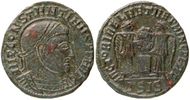 |
19x18mm 3.1gm The style is very good and the legends are almost correct. This coin is what I would classify as a counterfeit |
|
|
|
|
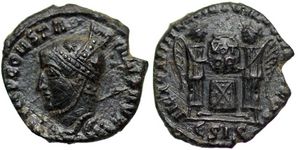 |
17mm 2.6gm could have possibly passed as real |
|
|
|
|
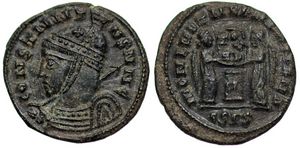 |
18x17mm 2.5gm very similar to
a coin found near Carnuntum
|
|
|
|
|
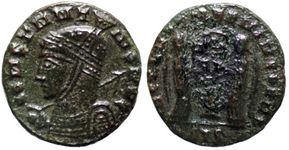 |
16mm 2.3 gm very similar to a coin found near Carnuntum obverse die
match with coin 3. They may been engraved by the
same person |
|
|
|
|
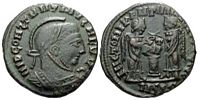 |
18mm 3.1gm |
|
|
|
|
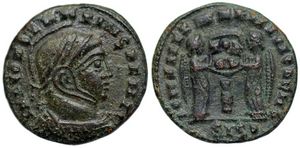 |
17mm 2.2gm |
|
|
|
|
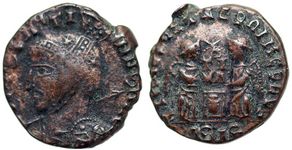 |
18mm 3.7gm |
|
|
|
|
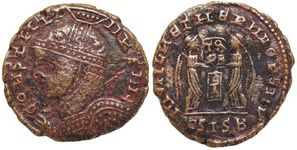 |
19x18mm 2.6gm |
|
|
|
|
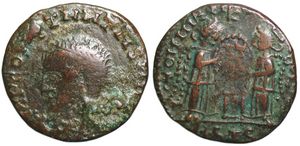 |
17mm 2gm |
|
|
|
|
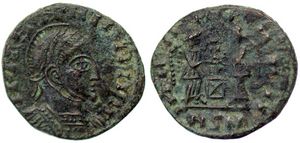 |
17mm 2.4gm |
|
|
|
|
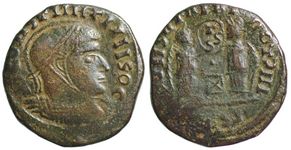 |
18mm 2.9gm |
|
|
|
|
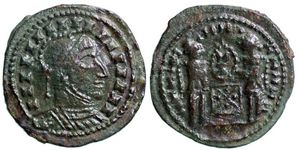 |
20x19mm 2.7gm |
|
|
|
|
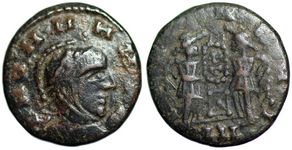 |
15mm 2.4gm |
|
|
|
|
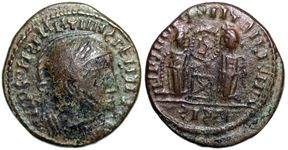 |
16mm 3gm |
|
|
|
|
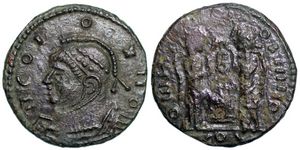 |
18mm 2.5gm looks like an 8 on the shield. note the similarity to coin 16. |
|
|
|
|
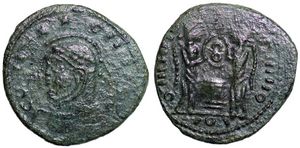 |
18mm 2.6gm looks like an 8 on the shield. note the similarity to coin 15 |
|
|
|
|
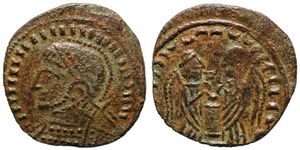 |
18mm 2.6gm |
|
|
|
|
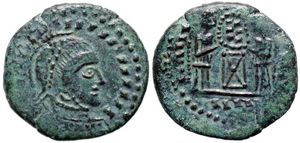 |
19x18mm 3.0gm |
|
|
|
|
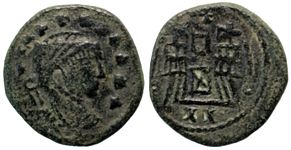 |
16mm 2.8gm |
|
|
|
|
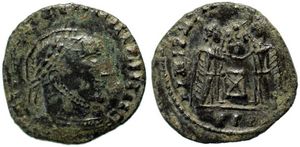 |
17mm 2.4gm |
|
|
|
|
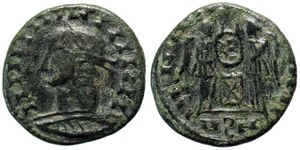 |
17mm 2.2gm die match with #22, #30, #62, #94 |
|
|
|
|
 |
16mm 2.6gm die match with #21, #30, #62, #94 |
|
|
|
|
Assorted Siscia VLPP imitations
despite a few die matches, most of the unofficial VLPP
coins on this page are from different dies (though a few look
like they were engraved by the same person); which
demonstrates the massive amount of these coins that were
minted-- perhaps more than official mintage.
|
|
|
|
|
|
|
|
Coin #24 16x17mm 2.1gm |
horseman on shield |
horseman on shield |
|
|
|
||||
Coin #28 19mm 2.8gm |
Coin #29 17mm 2.5gm |
Coin #30 16x17mm 2.1gm die match with #21 & #22 |
Coin #31 17x18mm 2.7gm |
Coin #32 19x21mm 3.1gm |
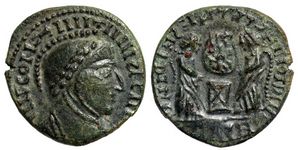 |
||||
Coin #33 18x19mm 2.4gm |
Coin #34 18mm 2.7gm |
Coin #35 16x17mm 3.5gm |
Coin #36 16x19mm 2.8gm irregular flan, good style |
Coin #37 18mm 3.3gm |
Coin #38 17mm 2.1gm uniface |
Coin #39 17x18mm 2.9gm |
Coin #40 18mm 2.9gm |
Coin #41 17x18mm 2.4gm some silvering |
Coin #42 17mm 2.6gm |
Coin #43 18mm 2.5gm T on shield |
Coin #44 19mm 3.9gm |
Coin #45 19mm 2.8gm |
Coin #46 18mm 3.0gm cross on altar |
Coin #47 18x19mm 2.2gm |
Coin #48 17mm 3.0gm silvered |
Coin #49 17mm 2.1gm |
Coin #50 16x17mm 2.1gm |
Coin #51 18mm 3.1gm |
Coin #52 18x19mm 3.5gm |
Coin #53 16x18mm 2.0gm |
Coin #54 17mm 2.5gm similar to coin #23 |
Coin #55 16mm 2.4gm |
Coin #56 16mm 1.9gm |
Coin #57 16mm 2.1gm |
|
Coin #58 18x19mm 2.1gm |
Coin #59 17mm 2.6gm |
Coin #60 17x18mm 2.9gm |
Coin #61 16x17mm 2.0gm |
Coin #62 16x17mm 2.1gm die match with #21, #22, #30, #94 |
Coin #63 17x18mm 3.9gm |
Coin #64 17mm 2.8gm |
Coin #65 16x17mm 2.4gm obverse die match with #3 & #4 |
Coin #66 17x18mm 2.6gm reverse match with #15 & #16 |
Coin #67 19mm 3.9gm very crude |
| Coin #68 17x19mm 2.0gm |
Coin #69 17mm 3.1gm |
Coin #70 18mm 3.2gm |
Coin #71 17x18mm 2.1gm |
Coin #72 17x18mm 3.0gm |
Coin #73 17x18mm 3.0gm |
Coin #74 15mm 2.0gm |
Coin #75 17mm 2.2gm |
Coin #76 15x16mm 1.9gm |
Coin #77 17mm 2.8gm |
Coin #78 17x18mm 2.1gm |
Coin #79 16mm 2.4gm |
Coin #80 17mm 2.4gm |
Coin #81 16mm 3.2gm |
Coin #82 17mm 2.7gm |
Coin #83 17x19mm 3.1gm |
Coin #84 17x18mm 2.1gm |
Coin #85 18x19mm 3.0gm |
Coin #86 17mm 2.3gm reverse die match with #15 #16 #66 obverse die match with #16 #66 |
Coin #87
17x18mm 2.3gm |
Coin #88
16mm 2.1gm |
Coin #89
15x16mm 2.2gm |
Coin #90
20mm 3.9gm |
Coin #91
16x19mm 2.8gm |
Coin #92
17x18mm 2.4gm |
Coin #93
15x17mm 2.1gm |
Coin #94 17mm 1.9gm die match with #21, #22, #30, #62 |
Coin #95 17x20mm 3.3gm |
Coin #96
17x19mm 2.7gm |
Coin #97
16x17mm 2.9gm |
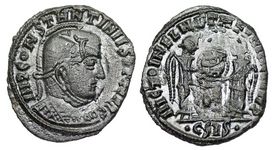 |
||||
Coin #98
19x21mm 3.1gm |
Coin #99 16x17mm 2.0gm |
Coin #100 17mm 2.1gm |
Coin #101
17x18mm 2.3gm |
Coin #102
17x18mm 2.6gm |
Coin #103
17mm 2.3gm |
Coin #104
17mm 2.8gm |
Coin #105
16mm 1.9gm |
Coin #106
17x18mm 2.6gm |
Coin #107
19mm 3.1gm |
| Coin #108 15x16mm 2.6gm wolf and twins on shield |
Coin #109 18x19mm 2.6gm horseman on shield |
Coin #110 17mm 3.3gm cross (?) on altar |
Coin #111
15x17mm 2.4gm |
Coin #112
19mm 3.5gm |
Coin #113
16mm 2.1gm |
Coin #114
16x17mm 2.4gm |
Coin #115
18x19mm 3.1gm |
Coin #116
18mm 2.7gm |
Coin #117
17mm 2.2gm |
Coin #118
17x18mm 2.5gm |
Coin #119
17mm 2.8gm |
Coin #120
16x17mm 2.0gm |
Coin #121
17x18mm 2.0gm |
Coin #122
17x18mm 2.3gm |
Coin #123
18mm 2.2gm |
Coin #124
16mm 1.9gm |
Coin #125
17mm 2.6gm |
Coin #126
16x17mm 2.3gm |
Coin #127 16x17mm 2.4gm |
Coin #128 17mm 2.9gm |
Coin #129 16x17mm 2.1g |
Coin #130
17x18mm 3.1g |
Coin #131
19x20mm 2.6g |
Coin #132
19mm 2.9g |
Coin #133 15x16mm 1.6g |
Coin #134
17x18mm 2.9g |
Coin #135
17mm 2.3g |
Coin #136 18mm 2.4g compare with #3, 4, 65, 75, 78, 117, 119, 125, 129 |
Coin #137
17mm 2.1g |
Coin #138
17x18mm 2.5g |
Coin #139 21mm 4.0g overstruck on Licinius IOVI |
Coin #140 18mm 2.8g |
Coin #141 21x22mm 3.0g overstruck on Licinius IOVI |
Coin #142
18x19mm 3.5g |
Coin #143
16mm 1.6g |
Coin #144
18mm 2.9g |
Coin #145 17mm 2.5g |
Coin #146 21mm 2.6g overstruck on Licinius IOVI |
Coin #147 16mm 2.8g |
Coin #148
16mm 2.8g |
Coin #149 17mm 3.5g |
Coin #150 18mm 2.6g |
Coin #151 17x18mm 2.9g |
Coin #152 17x18mm 2.1g looks like soldiers on reverse |
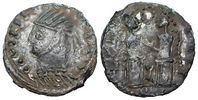 |
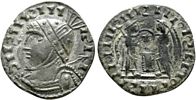 |
|||
|
Coin #153
15x16mm 1.8g die match with #26
|
Coin #154 17mm 2.3g die match with #26 |
Coin #155 16x18mm 3.6g |
Coin #156
15x16mm 1.7g |
Coin #157
17mm 1.8g |
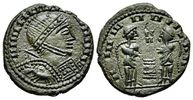 |
 |
 |
||
Coin #158
18mm 2.3g |
Coin #159
18mm 2.9g |
Coin #160 17mm 2.2g |
Die Matches
Die matches are
generally not very commonly found when looking at Roman
Imperial coins, however for unofficial coinage they are much
more frequently found by collectors. The main reason that they
are more easily found, is that given their nature, the styles
vary so greatly, that die matches tend to stick out. They are
more apparent than official coinage matches, which most
certainly could have as many die matches floating around, but
since official coinage styles look so similar, matches are
only found when careful attention is paid to the coins.
Unofficial die matches are also actually not very
useful to the numismatist. Die matches of official coinage are
used to answer questions concerning chronology or mint
organization, but the very nature of unofficial coinage means
that these questions cannot be answered. Unofficial coinage
was minted in so many different areas by different people that
the coins defy any ordering or cataloguing. At best,
speculation can be made about some coins looking similar and
perhaps being engraved by the same person. As far as
chronology for unofficial coins, one cannot speculate any
further than they were struck circa official issues. There is
no conceivable way to classify them as they were struck
without any order.
Ultimately
unofficial die matches are only a novelty…so enjoy the
example below!
Obverse and reverse die match
|
|
|
|
|
|
Suggested reading (arranged chronologically)
Andreas Alföldi, “Materialen zur Klassifizierung der
gleichzeitigen Nachahmungen von römischen Münzen aus Ungarn und
den Nachbärlandern.” Numizmatikai közlöny 25 (1926) : 37- 48,
plates 1-6.
The author looked at 232 examples of imitations, many of which
were Siscia VLPP imitations.
Arthur E. Robinson, “False and Imitation Roman Coins,” The
Journal of Antiquarian Association of the British Isles 2, no. 3
(December 1931) : 97- 112; vol. 2, no. 4 (March 1932) : 171- 184;
vol. 3, no. 1 (June 1932) : 3- 28.
The author looked at the holdings of museums in Great Britain
and wrote about the imitations he found.
P. V. Hill, “Barbarous Imitations of Fourth-Century Roman Coins,”
The Numismatic Chronicle 10 (1950) : 233- 270.
This work is compromised by the author's belief that some
barbarous coins were struck as late as the fifth century.
Philip Grierson, “The Roman Law of Counterfeiting.” Essays in Roman Coinage Presented to Harold Mattingly. Oxford University Press (1956) : 240- 261.
J. P. C. Kent, “Barbarous Copies of Roman Coins: Their
Significance for the British Historian and Archaeologist.”
Limes-Studien 14 (1957) : 61- 68.
Kent argued that imitations were struck contemporary with the
prototypes. By now, Hill agreed that barbs were not struck in
the 5th century.
A. Ravetz, “Neutron Activation Analysis of Silver in Some Late
Roman Copper Coins.” Archaeometry 6 (1963): 46- 55.
The author analyzed a few imitations of the Fel Temp galley
type.
L. H. Cope and H. N. Billingham, “The Composition of 35 Roman
Bronze Coins of the Period A.D. 284- 363.” Historical
Metallurgy 1 (1967) : 1- 6.
Three Fel Temp galley imitatives were analyzed
Katalin Biró-Sey, “Contemporary Roman Counterfeit Coins in the
Niklovits Collection.” Folia Archaeologica 28 (1977) : 91- 101.
This article talks about 24 imitations from a large Hungarian
collection, as well as imitations from the Transdanubia region
in general.
J. P. Callu and J. P. Garnier, “Minimi constantiniens trouvés ŕ
Reims, Appendice II: Corpus des imitations.” Numismatica e
Antichitŕ Classiche 6 (1977) : 330- 315.
This is a corpus of documented finds of imitations issued after
A.D. 330, including a map.
C. E. King, “The Alloy Content of Folles and Imitations from the
Woodeaton Hoard.” PACT 1 (1977) : 86- 100.
_________ “The Woodeaton (Oxfordshire) Hoard and the Problem of Constantinian Imitations, A.D. 330-41.” NC 18 (1978) : 38- 65.
Duval, Noël and Vladislav Popovic, eds. "Sirmium VIII. Études de
Numismatique Danubienne: Trésors, Lingots, Imitations. Monnaies de
Fouilles IV au XII Sičcle." Rome: Ecole francaise de Rome, 1978.
A lot of information on imitatives, however there is one
completely wrong statement-- "It should also be noted that all
these specimens are cast, as everywhere else in the Roman
empire." (pg 143). This is incorrect as many copies were struck,
in fact, the coins illustrated appear to have been struck.
J. N. Barrandon and C. Brenot. “Analyse
de monnaies de bronze (318- 340) par activation neutronique ŕ
l’aide d’une source isotopique de Californium 252.”
Collection de l'Ecole française de Rome 37 (1978) : 123- 144.
Analyzed 12 imitations of imitative VLPP's, silver content
ranged from .10- 2.5 %, with an average of 1.53%. No indication
of which mints they imitated though.
George C. Boon, “Counterfeit Coins in Roman Britain,” Coins and
the Archaeologist, London: Seaby (1988) : 102- 188.
A great overview of counterfeiting and imitative coinage in
Britain.
Pierre Bastien, "Imitations
of Late Roman Bronze Coins, 318-363" American Numismatic
Society Museum Notes 30 (1985): 144.
This is the standard work on 4th century imitations.
R. J. Brickstock,
"Copies of the FEL TEMP REPARATIO Coinage in Britain"
British Archeaological Reports (1987).
Kevin Butcher, “The
Maidenhatch Farm Hoard of Constantinian Copies” The
Numismatic Chronicle 152 (1992): 160-174.
This hoard contained 193 coins from A.D. 330- 341.,and all but
two were imitations
C. L. Duncan, Coin Circulation in the Danubian and Balkan
Provinces of the Roman Empire A.D. 294-578. London: Royal
Numismatic Society, 1993.
Interesting read, but concentrates on Pannonia and Dacia (no
Middle Danube) and very little on imitatives besides a few
references to minimissimi
C. E. King, "Roman Copies" Coin Finds and Coin Use in the Roman
World. Berlin: Gebr. Mann Verlag (1996) : 237-263.
After Bastien, this is the most informative and useful work on
imitatives.
Matthias Pfisterer and Heinz Winter, “Eine Sammlung
barbarisierter spätrömischer Münzen aus Carnuntum,” Mitteilungen
der Österreichischen Numismatische Gesellschaft volume 41, no.2
(2001) :27-41 and volume 41, no. 3 (2001) : 47- 61.
The authors wrote about 52 imitations found near
Carnuntum, which included 37 VLPP imitations.
Bursche, Aleksander. “Circulation of Roman Coinage in Northern
Europe in Late Antiquity.” Histoire & mesure XVII (2002).
"Barbarian counterfeits of denarii, aurei, siliquae and solidi
were minted — in a very limited number at that — mostly on
territory close to the limes." So they could have minted copies
of LRB's--particularly VLPP's, also. The author talks about the
function of Roman coins in German society, but ignores that
Tacitus said Germans used coins as currency on the frontiers,
versus bullion in the interior, stating that what Tacitus said
was a classical topos (rhetorical invention) in reference to Germania
with no mention of Annals.
Bursche, Aleksander. "Contacts between the Late Roman Empire and North-Central Europe." The Antiquaries Journal 76 (1996): 31-50.
Moisil, Delia. “The Danube Limes and the Barbaricum (294-498
A.D.) A Study In Coin Circulation.” Histoire & mesure XVII
(2002).
While not talking specifically about the Middle Danube, the
author had this to say about imitations, "It is still difficult
to establish if they should be assigned to barbarous people in
the Danube area, to semi-official Roman mints or to individuals
interested in getting some profit from this work."
Andrey Sergeev “Barbarian Coins on the Territory between the
Balkans and Central Asia” State Historical Museum of Russia
(2012)
1Boon, George C. “Counterfeit Coins in Roman Britain.” Coins and the Archaeologist. London: Seaby (1980) : 102- 188.
2Pierre Bastien, "Imitations of Late Roman Bronze Coins, 318-363" American Numismatic Society Museum Notes 30 (1985): 144.
3 George C. Boon, “Counterfeit Coins in Roman Britain,” Coins and the Archaeologist, London: Seaby (1980) : 137.
4J. Barrandon & J. P. Callu & C. Brenot in their article, "The Analysis of Constantinian Coins (A.D. 313-40) By Non-Destructive Californium 252 Activation Analysis," Archaeometry 19 (1977): 173-186, found that examples of the VLPP imitative from Trier averaged less than 2% silver.
5I have heard that the phrase
"make money hand over fist" referred to the minting practice of
holding the die in your fist and striking with a hammer in your
other hand. It is actually an old naval term referring to hauling
ropes and meant making progress, but it works for this analogy.
6Pierre Bastien, "Imitations of Late Roman Bronze Coins, 318-363" American Numismatic Society Museum Notes 30 (1985): 144.
7 Ibid.,160.
8 A few examples-- Kevin Butcher, “The Maidenhatch Farm Hoard of Constantinian Copies” The Numismatic Chronicle 152 (1992): 160-174. Andreas Alföldi, “Materialen zur Klassifizierung der gleichzeitigen Nachahmungen von römischen Münzen aus Ungarn und den Nachbärlandern.” Numizmatikai közlöny 25 (1926) : 37- 48, plates 1-6. Matthias Pfisterer and Heinz Winter, “Eine Sammlung barbarisierter spätrömischer Münzen aus Carnuntum,” Mitteilungen der Österreichischen Numismatische Gesellschaft volume 41, no.2 (2001) :27-41 and volume 41, no. 3 (2001) : 47- 61.
9Pitts, Lynn F. “Relations Between Rome and the German ‘Kings’ on the Middle Danube in the First to Fourth Centuries A.D.” JRS 79 (1989) : 55.
10 Bursche, Aleksander. “Circulation of Roman Coinage in Northern Europe in Late Antiquity.” Histoire & mesure XVII (2002). "Barbarian counterfeits of denarii, aurei, siliquae and solidi were minted — in a very limited number at that — mostly on territory close to the limes."
11Pitts, Lynn F. “Relations Between Rome and the German ‘Kings’ on the Middle Danube in the First to Fourth Centuries A.D.” JRS 79 (1989) : 57.
12Tabula Imperii Romani M33; J. Wielowiejski, "Die Kontakte Noricums und Pannoniens mit den Nordlichen Volkern im Lichte der romische Importe" in H. J. Dolle (ed.) Romer und Germanen in Mitteleuropa (1975) 69- 86.
13 Within the City of Rome no person shall wear either trousers or boots. But if any man after the issuance of this regulation of Our Clemency should obstinately persist in such contumacy, he shall be punished according as his legal status permits and expelled from our sacred City.” Codex Theodosianus 14.10.3 June 6, 399.
14 Andreas Alföldi, “The
Helmet of Constantine with the Christian Monogram.” The Journal of
Roman Studies 22 (1932) : 16.
last modified on 29 Sept 2023